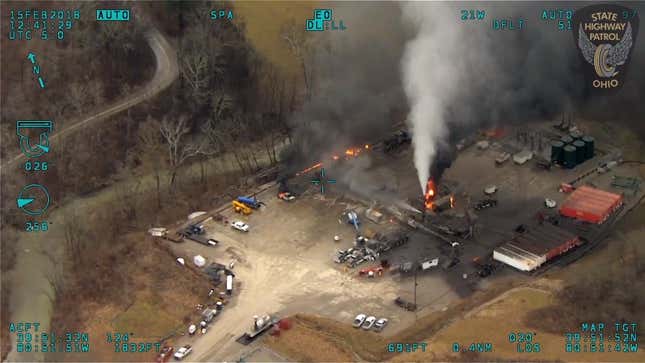
Research published this week shows that the blowout of an ExxonMobile-owned natural gas well in Belmont County, Ohio in February 2018 released a hell of a lot more methane than previously thought.
Per CNN, Dutch and American scientists published a study in the Proceedings of the National Academy of Sciences on Monday that used satellite data to estimate the blowout’s total emissions of methane at 60 kilotons. Methane has up to 25 times the greenhouse gas potential of CO2 over a 100-year period, though it has historically proven difficult to quantify just how much methane is actually spewing from well blowouts, fissures in pipelines, and intentional releases from high-pressure gas valves and pipeline compressors.
Over the course of 20 days, the researchers found, ExxonMobil subsidiary XTO Energy’s busted-ass well released more methane than all but three European countries do annually. According to the Washington Post and New York Times, the 60 kiloton figure is unsurprisingly five times greater than Exxon’s original assessment of the leak and places the incident as the second-largest U.S. methane leak in history.
“We deeply regret this incident occurred and are committed to identifying and managing risks associated with our activities to prevent recurrence,” ExxonMobil spokeswoman Julie L. King told the Post in an email.
Another company spokesperson, Casey Norton, told the Times their researchers had arrived at the lower estimate via pressure gauges at the well and studying imagery. Norton said the energy giant had “agreed to sit down and talk further to understand the discrepancy and see if there’s anything that we can learn... This was an anomaly. This is not something that happens on any regular basis. And we do our very best to prevent this from ever happening.”
Researchers were able to focus the European Space Agency’s Tropospheric Monitoring Instrument, which had just made it to space on the Sentinel-5 Precursor satellite, on the Ohio blowout on day 13. U.S.-based researcher Steven Hamburg of the Environmental Defense Fund (EDF), which was working on the satellite program with the Netherlands Institute for Space Research in Utrecht, told reporters that the study’s primary accomplishment was demonstrating the effectiveness of a new way of locating and measuring methane leaks. The EDF believes that the Environmental Protection Agency is underestimating the gas and oil industry’s methane emissions by 60 percent, according to the Post.
“Methane emissions are a huge contributor to climate change,” Hamburg told the Post. “But source locations are often unpredictable and can occur in out-of-the-way places all over the globe. New results show the opportunity for satellites to help see and quantify emissions no matter where they are.”
Hamburg also told the Times that the research demonstrates energy companies don’t have the methane leak problem “under control” as claimed, “because they didn’t understand what was actually happening.” He added, “Is this a once a year kind of event? Once a week? Once a day? Knowing that will make a big difference in trying to fully understand what the aggregate emissions are from oil and gas.”
“We’re entering a new era,” study co-author Ilse Aben told the Times. “With a single observation, a single overpass, we’re able to see plumes of methane coming from large emission sources. That’s something totally new that we were previously not able to do from space.”